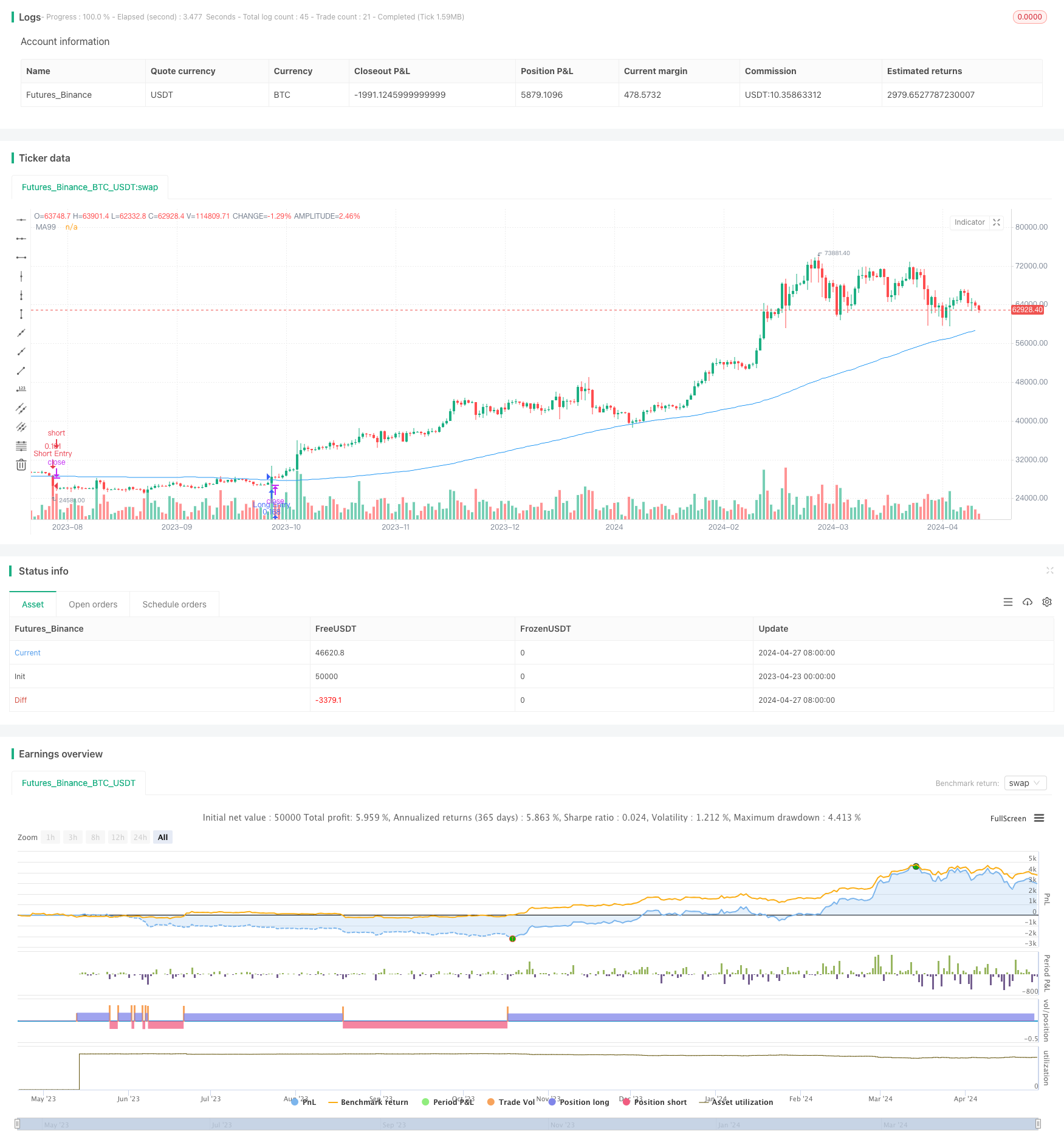
概述
该策略基于99周期简单移动平均线(MA99)来判断交易信号。当价格触及MA99时即可开仓,无需两根K线确认。而止损则采用动态止损,即当价格突破MA99并在下一根K线中得到确认时,即平仓止损。该策略旨在捕捉价格在MA99附近的波动,同时通过动态止损来控制风险。
策略原理
- 计算99周期简单移动平均线MA99。
- 判断当前价格是否触及MA99,即最低价低于等于MA99且最高价高于等于MA99。
- 若价格触及MA99且收盘价高于MA99,则做多;若价格触及MA99且收盘价低于MA99,则做空。
- 对于多头仓位,若收盘价跌破MA99且下一根K线再次确认,则平仓;对于空头仓位,若收盘价突破MA99且下一根K线再次确认,则平仓。
- 每次开仓时,将当前MA99设为止损价位;每次平仓后,重置止损价位。
策略优势
- 简单易用:该策略基于单一指标MA99,规则清晰明了,易于理解和实施。
- 动态止损:与固定止损相比,动态止损可以更好地适应市场变化,及时控制风险。
- 趋势跟踪:MA99代表中长期趋势,在价格触及MA99时开仓,能够跟随主要趋势方向交易。
- 减少噪音:相比于使用更短周期的均线,99周期均线能够有效过滤短期波动噪音。
策略风险
- 参数优化:该策略仅使用了99这一参数,可能并非最优参数,需要通过回测和优化来确定最佳参数。
- 震荡市:在震荡市场中,价格在MA99附近频繁波动,可能导致频繁交易和损失。
- 趋势转折:当趋势转折、价格突破MA99后,该策略可能会继续持有错误方向的仓位而遭受损失。
- 滑点成本:频繁交易可能会带来较高的滑点和交易成本,影响策略收益。
策略优化方向
- 引入趋势过滤:在判断开仓信号时,可以结合其他趋势指标如MACD、ADX等,以确认趋势强度和方向,提高开仓质量。
- 优化参数:对MA周期、止损条件等参数进行优化,找到最佳参数组合,提高策略稳健性。
- 加入仓位管理:根据市场趋势强度、波动率等因素动态调整仓位大小,控制回撤风险。
- 考虑交易成本:在回测和实盘中,应考虑交易滑点、手续费等成本因素,以评估策略实际表现。
总结
MA99接触与动态止损策略通过判断价格与MA99的关系来开仓,并采用动态止损来控制风险。该策略简单易用,能够跟随中长期趋势,但在震荡市中可能面临频繁交易的问题。通过引入其他指标过滤、优化参数、仓位管理和考虑成本等措施,可以进一步提升该策略的表现和稳健性。
策略源码
/*backtest
start: 2023-04-23 00:00:00
end: 2024-04-28 00:00:00
period: 1d
basePeriod: 1h
exchanges: [{"eid":"Futures_Binance","currency":"BTC_USDT"}]
*/
// This Pine Script™ code is subject to the terms of the Mozilla Public License 2.0 at https://mozilla.org/MPL/2.0/
//@version=5
strategy("MA99 Temas ve Dinamik Stop-Loss Stratejisi", overlay=true, default_qty_type=strategy.percent_of_equity, default_qty_value=10)
// MA99 hesaplayalım
ma99 = ta.sma(close, 99)
plot(ma99, color=color.blue, title="MA99")
// Fiyatın MA99'a temas edip etmediğini kontrol edelim
priceTouchedMA99 = (low <= ma99 and high >= ma99)
// Long ve short koşullarını tanımlayalım
longCondition = priceTouchedMA99 and close > ma99
shortCondition = priceTouchedMA99 and close < ma99
var float longStopLoss = na
var float shortStopLoss = na
var int longStopTriggered = 0
var int shortStopTriggered = 0
// Alım veya satım sinyallerine göre işlemleri başlatalım ve stop-loss ayarlayalım
if (longCondition)
strategy.entry("Long Entry", strategy.long)
longStopLoss := ma99
longStopTriggered := 0
if (shortCondition)
strategy.entry("Short Entry", strategy.short)
shortStopLoss := ma99
shortStopTriggered := 0
// Stop-loss koşullarını ve iki mum kuralını kontrol edelim
if (not na(longStopLoss))
if (close < longStopLoss)
longStopTriggered := 1
else
longStopTriggered := 0
if (longStopTriggered[1] == 1 and close < longStopLoss) // Bir önceki mumda tetiklendi ve hala altında
strategy.close("Long Entry", comment="Stop Loss Long")
longStopLoss := na
longStopTriggered := 0
if (not na(shortStopLoss))
if (close > shortStopLoss)
shortStopTriggered := 1
else
shortStopTriggered := 0
if (shortStopTriggered[1] == 1 and close > shortStopLoss) // Bir önceki mumda tetiklendi ve hala üstünde
strategy.close("Short Entry", comment="Stop Loss Short")
shortStopLoss := na
shortStopTriggered := 0
相关推荐